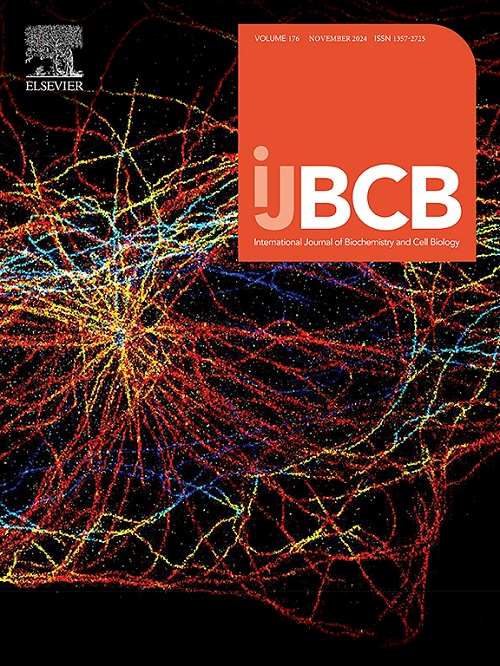Multi-omics analysis of transcriptome and proteome reveals that BAZ1A and BAZ2A have common and individual regulatory roles in hepatocellular carcinoma
IF 2.8
3区 生物学
Q2 BIOCHEMISTRY & MOLECULAR BIOLOGY
International Journal of Biochemistry & Cell Biology
Pub Date : 2025-02-01
DOI:10.1016/j.biocel.2024.106730
引用次数: 0
Abstract
This study employs an integrative multi-omics approach to elucidate the complex regulatory roles of BAZ1A and BAZ2A, subunits of the ISWI chromatin remodeling complexes, in hepatocellular carcinoma (HCC). Utilizing siRNA-mediated knockdown, combined with high-throughput RNA sequencing and mass spectrometry, the researchers reveal distinct and overlapping functions of BAZ1A and BAZ2A in both transcriptional and proteomic regulation. The findings indicate that BAZ1A is primarily involved in ribosomal biogenesis and nucleolar function, while BAZ2A exerts significant influence on cell cycle progression and DNA repair mechanisms. Through a comprehensive analysis of the transcriptome and proteome following gene knockdown, the study highlights the intricate interplay between these two subunits, which contributes to the pathogenesis of HCC. This integrated approach not only uncovers their differential impact on gene expression and protein abundance but also reveals their involvement in alternative splicing events. Additionally, potential downstream targets and associated signaling pathways are identified, providing valuable insights into the molecular mechanisms underlying HCC development. The distinct roles of BAZ1A and BAZ2A in various cellular processes, along with their differential effects on gene and protein regulation, position them as promising therapeutic targets. These results offer new perspectives for understanding the molecular basis of HCC and suggest potential avenues for targeted therapies.
转录组学和蛋白质组学的多组学分析表明,BAZ1A和BAZ2A在肝细胞癌中具有共同和单独的调节作用
本研究采用综合多组学方法阐明了ISWI染色质重塑复合物亚基BAZ1A和BAZ2A在肝细胞癌(HCC)中的复杂调控作用。利用sirna介导的敲低,结合高通量RNA测序和质谱分析,研究人员揭示了BAZ1A和BAZ2A在转录和蛋白质组学调控中的不同和重叠的功能。研究结果表明,BAZ1A主要参与核糖体生物发生和核仁功能,而BAZ2A对细胞周期进程和DNA修复机制有显著影响。通过对基因敲低后转录组和蛋白质组的综合分析,该研究强调了这两个亚基之间复杂的相互作用,这有助于HCC的发病。这种综合的方法不仅揭示了它们对基因表达和蛋白质丰度的差异影响,而且揭示了它们参与替代剪接事件。此外,潜在的下游靶点和相关的信号通路被确定,为HCC发展的分子机制提供了有价值的见解。BAZ1A和BAZ2A在各种细胞过程中的不同作用,以及它们对基因和蛋白质调控的不同作用,使它们成为有希望的治疗靶点。这些结果为理解HCC的分子基础提供了新的视角,并为靶向治疗提供了潜在的途径。
本文章由计算机程序翻译,如有差异,请以英文原文为准。
求助全文
约1分钟内获得全文
求助全文
来源期刊
CiteScore
8.10
自引率
0.00%
发文量
124
审稿时长
19 days
期刊介绍:
IJBCB publishes original research articles, invited reviews and in-focus articles in all areas of cell and molecular biology and biomedical research.
Topics of interest include, but are not limited to:
-Mechanistic studies of cells, cell organelles, sub-cellular molecular pathways and metabolism
-Novel insights into disease pathogenesis
-Nanotechnology with implication to biological and medical processes
-Genomics and bioinformatics

 求助内容:
求助内容: 应助结果提醒方式:
应助结果提醒方式:


